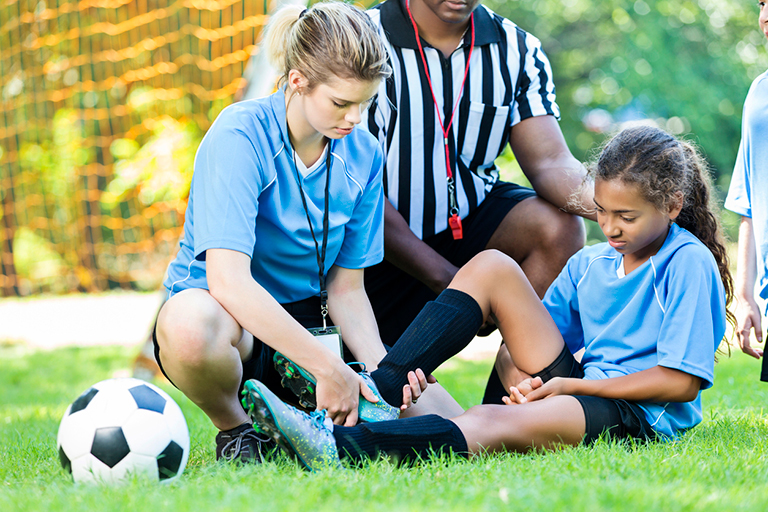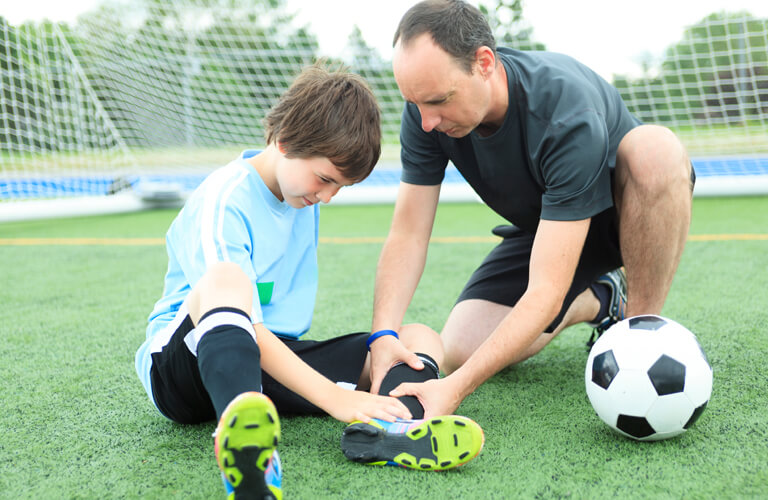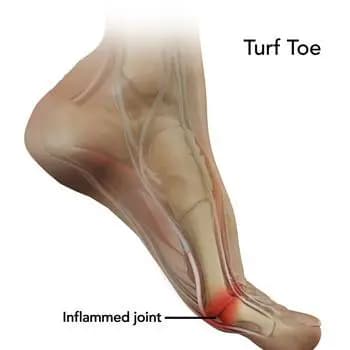Foot and Ankle Sports Medicine
Sports Medicine Injuries involving the foot and ankle
Sports are designed to push and challenge your body, which can lead to injury if you aren’t careful. This is especially true for your feet and ankles, which are your mainstays for most athletic endeavors. From running, jumping, pivoting, and stopping, these two areas are put through significant stress, and sometimes the results can be sidelining.

At Apex Foot & Ankle Institute, with Dr. Ryan M. Sherick at the helm, our goal is to keep our Thousand Oaks, California, patients healthy and active, which is why we offer innovative sports medicine services for foot and ankle-related injuries. An injury to your foot or ankle can not only take you out of the game, it can limit your everyday life in significant ways.
To keep you in the game, there are a few steps you can take to safeguard your feet and ankles starting with making an appointment below with Dr. Ryan M. Sherick or by calling (805) 904-0476.
What is sports medicine involving the foot & Ankle?
If you or your child sustains a lower extremity injury while participating in a sport such as running, basketball, soccer, football, tennis, baseball, softball, or any sport that leads to such a lower extremity sports injury it is then advisable to consult a physician who specializes in sports medicine of the foot and ankle or treats sports-related injuries, such as Dr. Ryan M. Sherick, at Apex Foot & Ankle Institute.
Dr. Ryan M. Sherick will not only treat your injury and develop a comprehensive treatment plan to expedite your recovery, but he will also teach you how to avoid future sports injuries.
What are common lower extremity sports injuries?
The most common types of sports injuries include:
Ankle Sprain or Ankle Instability
Shin Splints
Midfoot Pain
Stress Fractures
Arch Pain
Turf Toe or Toe Pain
Achilles Tendon Injuries
Heel Pain
Muscle Strain or Tendon Injuries
By following a well-tailored training program that balances the lower extremities, while still incorporating effective stretching and adequate rest, maintaining a balanced diet, and considering sports supplementation, you can significantly reduce the likelihood of experiencing injuries and enhance your recovery speed. Therefore, it’s vital to have a discussion with Dr. Sherick about your fitness routine and overall health regimen.
Here’s a look at the most common foot and ankle sports injuries and how to prevent them.
Sprained ankle Far and away, the most common injury to your lower appendages is a sprained ankle. In fact, sprained ankles top the list of the most common sports injuries overall, and a whopping 28,000 people sprain an ankle every day in the United States, both on and off the field.
There are varying degrees of sprained ankles — some are simple ligament strains that hobble you for a week or two, while others are more complex and may require surgery.
If you’re involved in a sport where your ankles are working hard (think basketball, soccer, and any other sport that involves jumping and pivoting), you’d do well to wear shoes that provide adequate ankle support. As well, you should spend a little time off the field and in the gym, strengthening your ankles through balancing exercises.
Achilles tendonitis Your Achilles tendon is the largest tendon in your body, and it attaches your calf muscle to your heel. If you overuse or overstress this tendon, it can develop tiny little tears that lead to the pain and inflammation that are the hallmarks of Achilles tendonitis. This overuse injury is common among runners and can be avoided if you know the early signs.
To start, we recommend that anyone who engages in concussive sports like running consider using orthotics for extra support. Even more important is recognizing when your Achilles tendon is stressed and giving it a good rest so that the tiny tears can heal. We can also recommend some good physical therapy exercises that will help strengthen your Achilles tendon and increase its flexibility.
Turf toe This sports injury, which was named for football players who played on artificial turf, occurs when you hyperextend your big toe and sprain the main joint. If you engage in any sport that requires you to sprint or push off from your toes, you run the risk of turf toe.
Unfortunately, there isn’t much you can do to prevent this acute injury, but the care you take afterward can make all the difference in your recovery. Through rest and expert oversight at our practice, we will ensure your toe heals properly and is strong enough to get you back out on the field.
Stress fractures Rounding out our list of the most common sports injuries are stress fractures, which are tiny cracks in your bones that can develop over time. This type of injury is more common among athletes who run on hard surfaces or athletes who push themselves too hard and too fast.
To prevent stress fractures, we recommend that you outfit yourself with the right footwear for your sport, as well as the proper support. Here again, your best defense is listening to your body and dialing back at the first signs of trouble. If you’re experiencing unexplained pain in your feet, it’s a good idea to have us check it out because if you have small fractures, they can quickly get worse.
Top Foot and Ankle Sports Injury Prevention
Tips with Dr. Ryan M. Sherick
Warm Up:
Before engaging in any sports activity, ensure you warm up adequately. Warming up involves light jogging and stretching to prepare your muscles and the intricate bones and joints in the feet and ankles for the demands of exercise. This not only reduces the risk of injury but also enhances your performance.
Strengthen & Condition:
Regularly conditioning the muscles and joints in your feet and ankles is crucial. This includes targeted strengthening exercises and stretching to build muscle, enhance balance, improve flexibility, increase range of motion, and stabilize your joints. Conditioning is a gradual process that significantly lowers the risk of injury.
Protect Your Feet:
Feet are your foundation, and the right footwear is essential for optimal performance. Choose sports-specific shoes that offer support, comfort, and durability. The correct athletic shoe can help prevent injuries such as sprains, stress fractures, and tendinitis. Be sure to replace worn-out shoes promptly. Find the perfect fit for your sport and foot type with our expert tips.
Start Slow:
If you’re not accustomed to regular sports activity or lack a consistent fitness routine, it’s wise to gradually increase your activity level. Jumping into high-intensity sports or long-distance running after a period of inactivity can strain unconditioned muscles and joints in your feet, leading to sprains, strains, or stress fractures.
Be Cautious of the Sports Surface:
Exercise caution when running or training on uneven surfaces, such as nature trails with loose debris or obstructed terrain, as well as steep inclines or declines. These conditions increase the risk of injury, so choose your training surfaces wisely.
Don’t Push Through Pain or Ignore Pain
Pay close attention to your body and its signals. If you experience pain during physical activity or persistent discomfort, seek medical attention. Ignoring pain can lead to injuries or worsen existing ones. Listening to your body is a fundamental aspect of injury prevention.
By following these injury prevention tips, you can reduce the risk of foot and ankle injuries while enjoying your favorite sports and activities.
How can I prevent foot and ankle sports injuries?
Our expert foot and ankle team is proud to offer advanced injury care and valuable guidance on injury prevention, tailored to the unique needs of Thousand Oaks, Westlake Village, Conejo Valley, Simi Valley, Calabasas, and Malibu residents. Explore our specialized tips below to protect your feet and ankles and remain injury-free in your scenic California surroundings.

What are my treatment options?
If your sports injury is severe enough to warrant medical attention, your rehabilitation strategy will be determined by the severity of the damage.
To begin, Dr. Sherick will identify the nature and severity of your injury – a determination that may need a stress X-ray, magnetic resonance imaging (MRI) scan, or ultrasound.

If you have an injury to your foot or ankle, he may offer a mix of treatment options, including the following:
Healing therapies such as PRP and Extracorporeal Shockwave for sports injuries.
Bracing, Custom Orthotics or Physical therapy
Anti-inflammatory medication or Homeopathic Pain Modalities
Minimally Invasive Surgery or Arthroscopic Surgery of the Foot and Ankle
Dr. Ryan M. Sherick is a Fellowship-Trained Foot & Ankle Surgeon with extensive experience in foot and ankle sports medicine. Dr. Sherick proudly provides treatment for all foot and ankle-related sports injuries to the following areas in Southern California: Thousand Oaks, Westlake Village, Agoura Hills, Malibu, Calabasas, West Hills, Chatsworth, and the entire Conejo Valley, Santa Rosa Valley, San Fernando Valley and greater Los Angeles area.
Request An Appointment
Need Help With Your Foot And Ankle?
